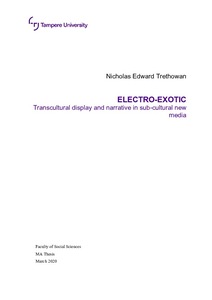Electro-exotic: Transcultural display and narrative in sub-cultural new media
Trethowan, Nicholas Edward (2020)
Trethowan, Nicholas Edward
2020
Master's Degree Programme in Cultural Studies
Yhteiskuntatieteiden tiedekunta - Faculty of Social Sciences
This publication is copyrighted. You may download, display and print it for Your own personal use. Commercial use is prohibited.
Hyväksymispäivämäärä
2020-05-12
Julkaisun pysyvä osoite on
https://urn.fi/URN:NBN:fi:tuni-202003032504
https://urn.fi/URN:NBN:fi:tuni-202003032504
Tiivistelmä
As the technological affordances and affordability of digital music sampling have continued to proliferate, so too have its aesthetics and semiotics along with the variety and orientations of its practitioners. With reference to such contexts and discourses aselectro-acoustic technique, commodificationof music, ethnography, sampling ethics and Orientalism, the present paper subjects Tanzania, a 2015 independent music release by the French artist Kink Gong, to multi-modal discursive analysis.Tanzania consists almost entirely of electro-acoustically remixed field recordings, made by the artist,of the music and speech of Hadza bushpeople.The three research aims of the study are to form an understanding of the aesthetics, meanings, ethics and problematics of the work, to contextualise critically this understanding using current theories and discussions of new media and cultural display, and to develop an improved understanding of the considerations pertinent to the ethical practice of transcultural sampling.These aims are fulfilled by identifying the varieties and semiotics of sampling practice in Tanzaniaand by discussing its narrative engagement with issues of power, agency, and the identification and display of cultures.The chief conclusionsof the study are that by embracing fantastical elements, Tanzania declines to display or describe real Hadza. In so doing, it subverts both traditional ethnography and world music commodification. Instead, the artist attempts to reimagine the specific historical event of his encounter with Hadza people as an undescriptive fantasy. Thus, the album navigates between the problematic poles of mere signification (general) and essentialist description (specific). It faces some trouble on both counts and, at its worst, seems to essentialise Hadza as instruments for the artist’sexperience. At perhaps its best, the album gestures by way of its extraordinary sonics towards a transcendent cultural experience and towards a self-reflective methodology for sampling practice.
